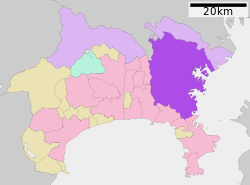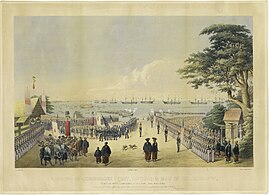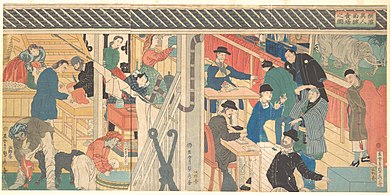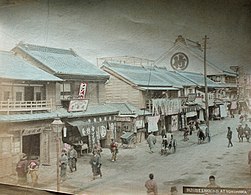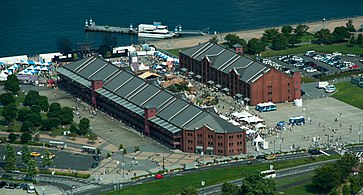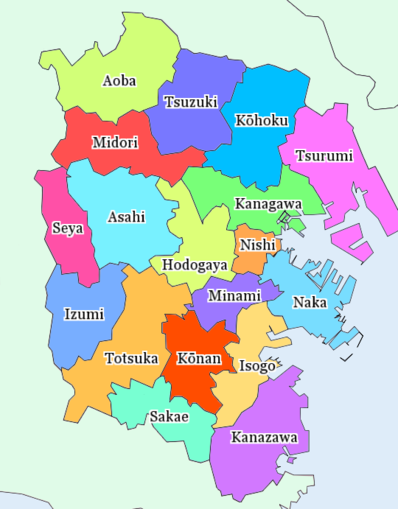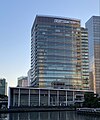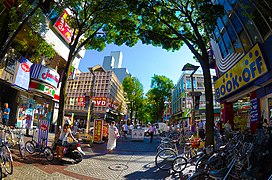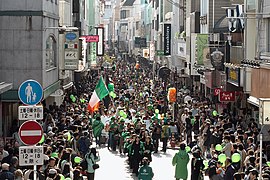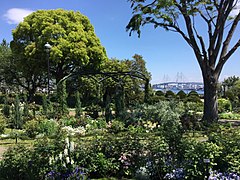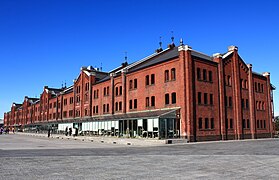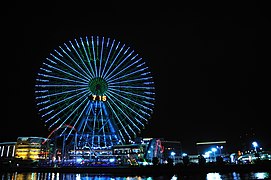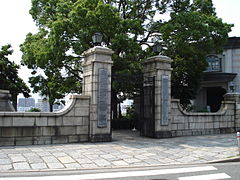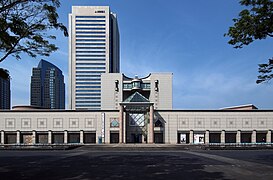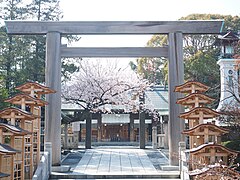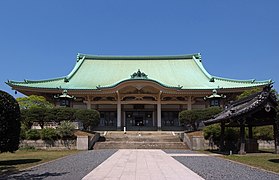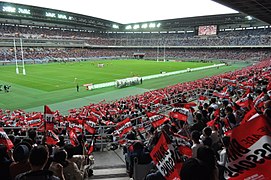|
Yokohama
Yokohama (Japanese: 横浜, pronounced [jokohama] ⓘ) is the second-largest city in Japan by population[1] and by area, and the country's most populous municipality.[a] It is the capital and most populous city in Kanagawa Prefecture, with a population of 3.7 million in 2023. It lies on Tokyo Bay, south of Tokyo, in the Kantō region of the main island of Honshu. Yokohama is also the major economic, cultural, and commercial hub of the Greater Tokyo Area along the Keihin Industrial Zone. Yokohama was one of the cities to open for trade with the West following the 1859 end of the policy of seclusion and has since been known as a cosmopolitan port city, after Kobe opened in 1853. Yokohama is the home of many Japan's firsts in the Meiji period, including the first foreign trading port and Chinatown (1859), European-style sport venues (1860s), English-language newspaper (1861), confectionery and beer manufacturing (1865), daily newspaper (1870), gas-powered street lamps (1870s), railway station (1872), and power plant (1882). Yokohama developed rapidly as Japan's prominent port city following the end of Japan's relative isolation in the mid-19th century and is today one of its major ports along with Kobe, Osaka, Nagoya, Fukuoka, Tokyo and Chiba. Yokohama is the largest port city and high tech industrial hub in the Greater Tokyo Area and the Kantō region. The city proper is headquarters to companies such as Isuzu, Nissan, JVCKenwood, Keikyu, Koei Tecmo, Sotetsu and Bank of Yokohama. Famous landmarks in Yokohama include Minato Mirai 21, Nippon Maru Memorial Park, Yokohama Chinatown, Motomachi Shopping Street, Yokohama Marine Tower, Yamashita Park, and Ōsanbashi Pier. EtymologyYokohama (横浜) means "horizontal beach".[2] The current area surrounded by Maita Park, the Ōoka River and the Nakamura River have been a gulf divided by a sandbar from the open sea. This sandbar was the original Yokohama fishing village. Since the sandbar protruded perpendicularly from the land, or horizontally when viewed from the sea, it was called a "horizontal beach".[3] HistoryOpening of the Treaty Port (1859–1868)Before the Europeans arrived, Yokohama was a small fishing village up to the end of the feudal Edo period, when Japan held a policy of national seclusion, having little contact with foreigners.[4] A major turning point in Japanese history happened in 1853–54, when Commodore Matthew Perry arrived just south of Yokohama with a fleet of American warships, demanding that Japan open several ports for commerce, and the Tokugawa shogunate agreed by signing the Treaty of Peace and Amity.[5] It was initially agreed that one of the ports to be opened to foreign ships would be the town of Kanagawa-juku (in what is now Kanagawa Ward) on the Tōkaidō, a strategic highway that linked Edo to Kyoto and Osaka. However, the Tokugawa shogunate decided that Kanagawa-juku was too close to the Tōkaidō for comfort, and port facilities were instead built across the inlet in the fishing village of Yokohama. The Port of Yokohama was officially opened on June 2, 1859.[6] Yokohama quickly became the base of foreign trade in Japan. Foreigners initially occupied the low-lying district of the city called Kannai, residential districts later expanding as the settlement grew to incorporate much of the elevated Yamate district overlooking the city, commonly referred to by English-speaking residents as The Bluff. Under pressure from United States and United Kingdom officials, the Tokugawa government built a commercial sex district which opened on November 10, 1859, with 6 brothels and 200 indentured sex workers.[7]: 68 The area of Yokohama with the highest concentration of brothels was known as Bloodtown.[7]: 67 Kannai, the foreign trade and commercial district (literally, inside the barrier), was surrounded by a moat, foreign residents enjoying extraterritorial status both within and outside the compound. Interactions with the local population, particularly young samurai, outside the settlement inevitably caused problems; the Namamugi Incident, one of the events that preceded the downfall of the shogunate, took place in what is now Tsurumi Ward in 1862, and prompted the Bombardment of Kagoshima in 1863. To protect British commercial and diplomatic interests in Yokohama a military garrison was established in 1862. With the growth in trade increasing numbers of Chinese also came to settle in the city.[8] Yokohama was the scene of many notable firsts for Japan including the growing acceptance of western fashion, photography by pioneers such as Felice Beato, Japan's first English language newspaper, the Japan Herald published in 1861 and in 1865 the first ice cream confectionery and beer to be produced in Japan.[9] Recreational sports introduced to Japan by foreign residents in Yokohama included European style horse racing in 1862, cricket in 1863[10] and rugby union in 1866. A great fire destroyed much of the foreign settlement on November 26, 1866, and smallpox was a recurrent public health hazard, but the city continued to grow rapidly – attracting foreigners and Japanese alike.
Meiji and Taisho periods (1868–1923)After the Meiji Restoration of 1868, the port was developed for trading silk, the main trading partner being Great Britain. Western influence and technological transfer contributed to the establishment of Japan's first daily newspaper (1870), first gas-powered street lamps (1872) and Japan's first railway constructed in the same year to connect Yokohama to Shinagawa and Shinbashi in Tokyo. In 1872 Jules Verne portrayed Yokohama, which he had never visited, in an episode of his widely read novel Around the World in Eighty Days, capturing the atmosphere of the fast-developing, internationally oriented Japanese city. In 1887, a British merchant, Samuel Cocking, built the city's first power plant. At first for his own use, this coal power plant became the basis for the Yokohama Cooperative Electric Light Company. The city was officially incorporated on April 1, 1889.[11] By the time the extraterritoriality of foreigner areas was abolished in 1899, Yokohama was the most international city in Japan, with foreigner areas stretching from Kannai to the Bluff area and the large Yokohama Chinatown. The early 20th century was marked by rapid growth of industry. Entrepreneurs built factories along reclaimed land to the north of the city toward Kawasaki, which eventually grew to be the Keihin Industrial Area. The growth of Japanese industry brought affluence, and many wealthy trading families constructed sprawling residences there, while the rapid influx of population from Japan and Korea also led to the formation of Kojiki-Yato, then the largest slum in Japan.
Great Kantō earthquake and the Second World War (1923–1945)
Much of Yokohama was destroyed on September 1, 1923, by the Great Kantō earthquake. The Yokohama police reported casualties at 30,771 dead and 47,908 injured, out of a pre-earthquake population of 434,170.[12] Fuelled by rumors of rebellion and sabotage, vigilante mobs thereupon murdered many Koreans in the Kojiki-yato slum.[13] Many people believed that Koreans used black magic to cause the earthquake. Martial law was in place until November 19. Rubble from the quake was used to reclaim land for parks, the most famous being the Yamashita Park on the waterfront which opened in 1930. Yokohama was rebuilt, only to be destroyed again by U.S. air raids during World War II. The first bombing was in the April 18, 1942 Doolittle Raid. An estimated 7,000–8,000 people were killed in a single morning on May 29, 1945, in what is now known as the Great Yokohama Air Raid, when B-29s firebombed the city and in just one hour and nine minutes, reducing 42% of it to rubble.[11] Postwar growth and developmentDuring the American occupation, Yokohama was a major transshipment base for American supplies and personnel, especially during the Korean War. After the occupation, most local U.S. naval activity moved from Yokohama to an American base in nearby Yokosuka. Four years after the Treaty of San Francisco signed, the city was designated by government ordinance on September 1, 1956.[citation needed] The city's tram and trolleybus system was abolished in 1972, the same year as the opening of the first line of Yokohama Municipal Subway. Construction of Minato Mirai 21 ("Port Future 21"), a major urban development project on reclaimed land started in 1983, nicknamed the "Philadelphia and Boston of the Orient" was compared to Center City, Philadelphia and Downtown Boston located in the East Coast of the United States. Minato Mirai 21 hosted the Yokohama Exotic Showcase in 1989, which saw the first public operation of maglev trains in Japan and the opening of Cosmo Clock 21, then the tallest Ferris wheel in the world. The 860-metre-long (2,820 ft) Yokohama Bay Bridge opened in the same year. In 1993, Minato Mirai 21 saw the opening of the Yokohama Landmark Tower, the second-tallest building in Japan. The 2002 FIFA World Cup final was held in June at the International Stadium Yokohama. In 2009, the city marked the 150th anniversary of the opening of the port and the 120th anniversary of the commencement of the City Administration. An early part in the commemoration project incorporated the Fourth Tokyo International Conference on African Development (TICAD IV), which was held in Yokohama in May 2008. In November 2010, Yokohama hosted the Asia-Pacific Economic Cooperation (APEC) meeting.
Geography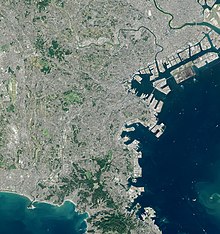 TopographyYokohama has a total area of 437.38 km2 (168.87 sq mi) at an elevation of 5 metres (16 ft) above sea level. It is the capital of Kanagawa Prefecture, bordered to the east by Tokyo Bay and located in the middle of the Kantō plain. The city is surrounded by hills and the characteristic mountain system of the island of Honshū, so its growth has been limited and it has had to gain ground from the sea. This also affects the population density, one of the highest in Japan with 8,500 inhabitants per km2. The highest points within the urban boundary are Omaruyama (156 m [512 ft]) and Mount Enkaizan (153 m [502 ft]). The main river is the Tsurumi River, which begins in the Tama Hills and empties into the Pacific Ocean.[14] These municipalities surround Yokohama: Kawasaki, Yokosuka, Zushi, Kamakura, Fujisawa, Yamato, Machida. GeologyThe city is very prone to natural phenomena such as earthquakes and tropical cyclones because the island of Honshū has a high level of seismic activity, being in the middle of the Pacific Ring of Fire. Most seismic movements are of low intensity and are generally not perceived by people. However, Yokohama has experienced two major tremors that reflect the evolution of Earthquake engineering: the 1923 Great Kantō earthquake devastated the city and caused more than 100,000 fatalities throughout the region,[15] while the 2011 Tōhoku earthquake and tsunami, with its epicenter on the east coast, was felt in the locality but only material damage was lamented because most buildings were already prepared to withstand them.[16] ClimateYokohama features a humid subtropical climate (Köppen: Cfa) with hot, humid summers and chilly winters.[17] Weatherwise, Yokohama has a pattern of rain, clouds and sun, although in winter, it is surprisingly sunny, more so than Southern Spain. Winter temperatures rarely drop below freezing, while summer can seem quite warm, because of the effects of humidity.[18] The coldest temperature was on 24 January 1927 when −8.2 °C (17.2 °F) was reached, whilst the hottest day was 11 August 2013 at 37.4 °C (99.3 °F). The highest monthly rainfall was in October 2004 with 761.5 millimetres (30.0 in), closely followed by July 1941 with 753.4 millimetres (29.66 in), whilst December and January have recorded no measurable precipitation three times each.
Demographics
The city's population is 3,772,726 as of 1 June 2024, making it the second-most populated city in the country after Tokyo's 23 special wards. Among Yokohama's 18 wards, the most inhabited was Kohoku with a population of 364,760, followed by Aoba (308,379), Tsurumi (297,230), and Totsuka (282,601). In terms of population density, Nishi and Minami are the most densely populated, with a per square kilometre population exceeding 15,000.[21] Of Yokohama's population, 1,548,077 work outside the city, while 1,226,618 workers commute from outside the city. As these numbers suggest, some of Yokohama's residential areas are commuter suburbs (or "bed towns" as known in Japanese) for those who work in other major cities, primarily Tokyo.[22] ImmigrationAs of June 2024, Yokohama's population includes 121,042 foreign nationals, making up 3.2% of the total population, with the number having grown significantly in recent years. While all three countries with the number of nationals living in Yokohama as citizens exceeding 10,000 are all in Asia (China, South Korea, Vietnam), other major countries of origin for Yokohama's non-Japanese residents include Brazil (2,823), the United States (2,793), Peru (1,312), the United Kingdom (840), and Germany (770).[23] There is no official survey of the citizens' countries of birth, hence these numbers do not include naturalized citizens, but they include foreign nationals born outside their country of citizenship. AdministrationMunicipal adminsitrationYokohama is one of the 20 designated cities in the country, which means the city has many powers that usually belong to prefectural governments, while having wards as subdivisions with administrative functions. Yokohama city consists of 18 wards, with its government seat in Naka Ward. The Yokohama City Council consists of 86 members elected from a total of 18 Wards. The LDP has minority control with 36 seats. The incumbent mayor is Takeharu Yamanaka, who defeated his predecessor Fumiko Hayashi in the 2021 Yokohama mayoral election. WardsYokohama has 18 wards (ku):
EconomyIn 2020, Yokohama's total gross regional product was 14.06 trillion yen or US$133 billion, a 1.9 per cent decrease compared to the previous year due to the COVID-19 pandemic. This converts to US$35,107 per citizen, below the national average. A large number of Yokohama's citizens work outside the city (693,064 in 2020), primarily in Tokyo, and the economic value they generate outside the city does not contribute to Yokohama's economic output. The largest contributors to this figure were wholesale and retail (17.8%), healthcare (11.7%), and academic, professional, or technological services (11.0%).[22] Major companies headquartered
Culture and sights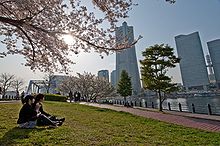 Yokohama's cultural and tourist sights include:
Museums There are 42 museums in the city area, including.[25]
Gallery
Excursion destinationsIn 2016, 46,017,157 tourists visited the city, 13.1% of whom were overnight guests.[25]
Sports
Transport Yokohama is serviced by the Tōkaidō Shinkansen, a high-speed rail line with a stop at Shin-Yokohama Station. Yokohama Station is also a major station, with two million passengers daily. The Yokohama Municipal Subway, Minatomirai Line and Kanazawa Seaside Line provide metro services. Air transportYokohama does not have an airport, but is served by Tokyo's two main airports Haneda Airport which is 17.4 km away and Narita International Airport which is 77 km away. Maritime transportYokohama is the world's 31st largest seaport in terms of total cargo volume, at 121,326 freight tons as of 2011[update], and is ranked 37th in terms of TEUs (Twenty-foot equivalent units).[27] In 2013, APM Terminals Yokohama facility was recognized as the most productive container terminal in the world averaging 163 crane moves per hour, per ship between the vessel's arrival and departure at the berth.[28] Rail transportRailway stations
EducationPublic elementary and middle schools are operated by the city of Yokohama. There are nine public high schools which are operated by the Yokohama City Board of Education,[29] and a number of public high schools which are operated by the Kanagawa Prefectural Board of Education. Yokohama National University is a leading university in Yokohama which is also one of the highest ranking national universities in Japan.
In popular culture
International relations Twin towns – sister cities
Yokohama also cooperates with:
Partner cities
Sister ports
Notable people
ReferencesCitations
Sources
Notes
External linksWikimedia Commons has media related to Yokohama.
|
||||||||||||||||||||||||||||||||||||||||||||||||||||||||||||||||||||||||||||||||||||||||||||||||||||||||||||||||||||||||||||||||||||||||||||||||||||||||||||||||||||||||||||||||||||||||||||||||||||||||||||||||||||||||||||||||||||||||||||||||||||||||||||||||||||||||||||||||||||||||||||||||||||||||||||||||||||||||||||||||||||||||||||||||||||||||||||||||||||||||||||||||||||||||||||||||||||||||||||||||||||||||||||||||||||||||||||










